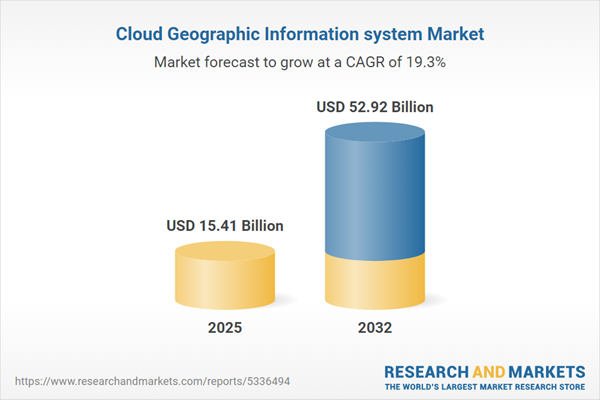Speak directly to the analyst to clarify any post sales queries you may have.
The Cloud Geographic Information System (Cloud GIS) Market is transforming enterprise spatial intelligence by equipping leaders with agile platforms for operational improvement, strategic planning, and responsive digital transformation across complex business environments.
Market Snapshot: Cloud GIS Market Growth Trajectory
The Cloud GIS Market is undergoing rapid and broad-based expansion as enterprises and public sector organizations accelerate adoption of spatial analytics within their digital strategies. In 2024, the market reached USD 12.92 billion and is projected to increase to USD 15.41 billion by 2025, with further growth to USD 52.92 billion by 2032. This forecast reflects a compound annual growth rate (CAGR) of 19.27%. Progress is driven by the need for real-time analytics, seamless platform interoperability, and emerging regulatory requirements that motivate migrations to cloud-native geospatial tools. Adoption is gaining pace in technologically advanced economies, with deployments also expanding across essential sectors where spatial data is becoming pivotal to business decision-making and operational management.
Scope & Segmentation: Strategic Opportunities in the Cloud GIS Market
Cloud GIS enables organizations of all sizes to harness powerful geospatial capabilities, fostering greater efficiency and adaptability to shifts in the business landscape. Senior decision-makers are utilizing a broad range of solution components and models to address specific challenges and goals:
- Component: Infrastructure as a Service, Platform as a Service, Software as a Service, as well as tailored GIS applications, meeting diverse demands from foundational data management to advanced analytics.
- Pricing Model: One Time Licensing, Perpetual Licensing, and Subscription approaches provide procurement flexibility, allowing leadership to match technology investments to operational growth or budget cycles.
- Organization Size: Both large enterprises and SMEs deploy cloud GIS to optimize resource management, control operational costs, and expand access to advanced geospatial analytics.
- Industry Vertical: Sectors including Agriculture, Government, Oil and Gas, Transportation and Logistics, and Utilities employ GIS to improve asset utilization, ensure compliance, and streamline core processes.
- Application: Data Integration, Map Visualization, and advanced Spatial Analytics are deployed to support transparency and informed action across various functions.
- Region: Leading uptake occurs in the Americas and Asia-Pacific, leveraging robust digital foundations, while EMEA regions advance through regulatory shifts and improved network infrastructure.
- Leading Companies: Technology providers such as Environmental Systems Research Institute, Hexagon AB, Trimble Inc., Bentley Systems, Oracle Corporation, Autodesk, Google LLC, HERE Global, Maxar Technologies, and SuperMap Software drive sector innovation and targeted solution delivery.
Key Takeaways for Senior Decision-Makers
- Adopting cloud GIS accelerates workforce onboarding and allows distributed teams to collaborate seamlessly, improving organizational responsiveness and operational agility.
- Integrating artificial intelligence and machine learning enriches predictive capabilities in asset management and enables proactive strategies across diverse business segments.
- IoT network integration enhances operational visibility, advancing risk management for critical infrastructure and geographically dispersed assets.
- Flexible procurement models empower organizations to finely tune investments and simplify technology transitions away from legacy systems.
- Hybrid and multi-cloud deployment options help meet compliance goals, facilitate data localization, and ease navigation of complex regulatory environments.
- Collaboration between GIS and cloud technology specialists drives the creation of industry-specific applications, with particular momentum in energy, public sector, logistics, and agriculture.
Tariff Impact: Strategic Procurement and Operational Costs
Volatility in tariff structures requires organizations to reevaluate procurement and operational strategies for cloud GIS. Shifting to subscription-based models offers cost predictability over traditional systems. Establishing custom service agreements and choosing data center locations aligned to operational needs help maintain compliance and mitigate risks, especially when managing sensitive or location-bound data.
Methodology & Data Sources
This analysis leverages direct interviews with industry experts, comprehensive reviews of peer-reviewed sources, and continuous data monitoring to inform recommendations for senior executives pursuing cloud GIS adoption at scale.
Why This Report Matters
- Enables executives to deploy proven strategies for cloud GIS adoption, unlocking new market potential and advancing enterprise digital transformation.
- Serves as an operational and procurement reference, equipping teams with tools to evaluate suppliers, manage risk, and ensure compliance across geographies.
- Supports seamless integration and rapid deployment of spatial solutions, driving higher process efficiency and organizational value.
Conclusion
Cloud GIS empowers organizations with scalable spatial intelligence, strengthening agility and enhancing decision-making to capture sustainable competitive advantages in dynamic business environments.
Additional Product Information:
- Purchase of this report includes 1 year online access with quarterly updates.
- This report can be updated on request. Please contact our Customer Experience team using the Ask a Question widget on our website.
Table of Contents
3. Executive Summary
4. Market Overview
7. Cumulative Impact of Artificial Intelligence 2025
Companies Mentioned
The companies profiled in this Cloud Geographic Information system market report include:- Environmental Systems Research Institute, Inc.
- Hexagon AB
- Trimble Inc.
- Bentley Systems, Incorporated
- Oracle Corporation
- Autodesk, Inc.
- Google LLC
- HERE Global B.V.
- Maxar Technologies Inc.
- SuperMap Software Co., Ltd.
Table Information
| Report Attribute | Details |
|---|---|
| No. of Pages | 184 |
| Published | November 2025 |
| Forecast Period | 2025 - 2032 |
| Estimated Market Value ( USD | $ 15.41 Billion |
| Forecasted Market Value ( USD | $ 52.92 Billion |
| Compound Annual Growth Rate | 19.2% |
| Regions Covered | Global |
| No. of Companies Mentioned | 11 |









